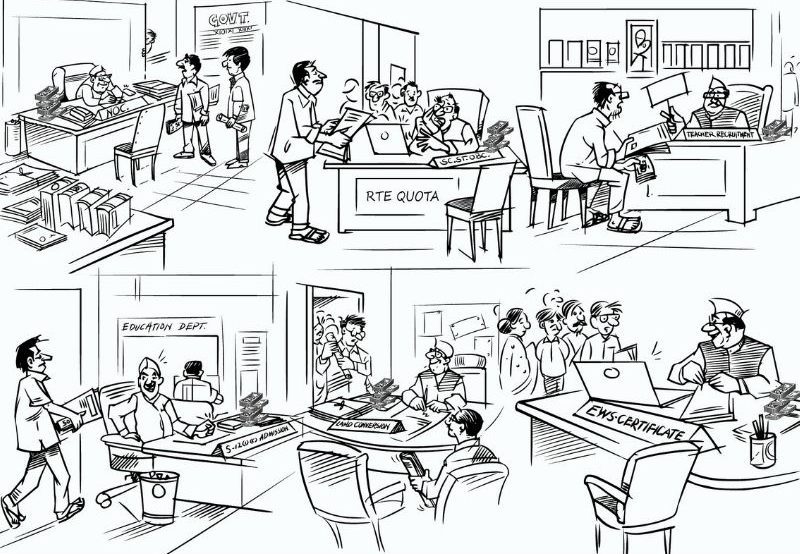In 2004, when this publication was a mere five years of age, we featured a cover story titled ‘Dirty Dozen Corrupt Practices Destroying Indian Education’. Almost two decades later, not only are the dirty dozen corrupt practices of the early millennium omnipresent, several new ones have been added to the list. – Dilip Thakore
 There’s a serious blindspot in Indian society. In his address to the nation on the eve of January 26 when the nation observed its 73rd Republic Day, President Ram Nath Kovind made only a cursory reference to human capital development, aka education, of the world’s largest child and youth population. Ditto on February 1, when Union finance minister Nirmala Sitharaman presented the Union Budget 2022-23, the best she could do was to raise the Central government’s outlay for education from Rs.93,223 crore in 2021-22 to Rs.104,278 crore, an increase of 11.86 percent over the previous year but a mere 5 percent over the pre-pandemic 2020-21.
There’s a serious blindspot in Indian society. In his address to the nation on the eve of January 26 when the nation observed its 73rd Republic Day, President Ram Nath Kovind made only a cursory reference to human capital development, aka education, of the world’s largest child and youth population. Ditto on February 1, when Union finance minister Nirmala Sitharaman presented the Union Budget 2022-23, the best she could do was to raise the Central government’s outlay for education from Rs.93,223 crore in 2021-22 to Rs.104,278 crore, an increase of 11.86 percent over the previous year but a mere 5 percent over the pre-pandemic 2020-21.
Admittedly, the Centre’s share of the annual expenditure on education is a small percentage (0.5 of GDP) of the national outlay on human capital development. The major share of over 3 percent of GDP is contributed by the country’s state governments and eight Union territories. Nevertheless, the Centre’s annual allocation which funds Central government schools (1,245 Kendriya Vidyalayas and 661 Jawahar Navodaya Vidyalayas) and 54 Central universities and higher education institutions such as the Indian Institute of Science, Bengaluru, 43 IITs and IIMs, is an important marker of the priority that the Centre accords to education of India’s children and youth aged below 24, whose number is estimated at over 500 million.
Curiously, indeed astonishingly, there seems little awareness in New Delhi or in the state capitals of the critical importance of nurturing and upgrading India’s children and youth in an era when all developed countries, including China, are experiencing falling birth rates and rapidly ageing populations. In the remainder of the 21st century India will have the largest working age (18-65) population of any country worldwide. If they are intensively educated and skilled, in the second half of the 21st century, this country could multiply its GDP 5x from the pathetic $3 trillion currently (cf. America’s $22 trillion and China’s $16 trillion) and transform into a respected producer of high quality manufactures, goods and services.
Instead, the annual per capita outlay for educating and skilling India’s 260 million school-going children and 40 million in tertiary education is a mere $970 per year. Against this, per capita expenditure on education in the US is $61,000, UK $46,000 and Japan $39,000.
Way back in 1967, the high-powered Kothari Commission recommended that the annual expenditure (Centre plus states) for educating India’s children should “not fall below” 6 percent of GDP. That target has never been attained. Since India wrested political independence from oppressive British rule in 1947, national expenditure on public education has averaged 3.5 percent of GDP.
Sustained underinvestment in human capital development — the direct outcome of abandoning India’s traditional free enterprise economic development model and adopting the Soviet-inspired public sector enterprises (PSEs)-driven model which resulted in perennially loss-making PSEs becoming a millstone of the Indian economy — has had terrible consequences. Over 300 million adults in 21st century India are comprehensively illiterate. Moreover, learning outcomes in primary education in rural India — which grudgingly hosts 60 percent of the population — as recorded in the Annual Status of Education Report (ASER) of the authoritative Pratham Education Foundation — are rock bottom, especially in government primary/elementary schools.
You cant read further without a subscription. If already a subscriber please Login or to subscribe click here























